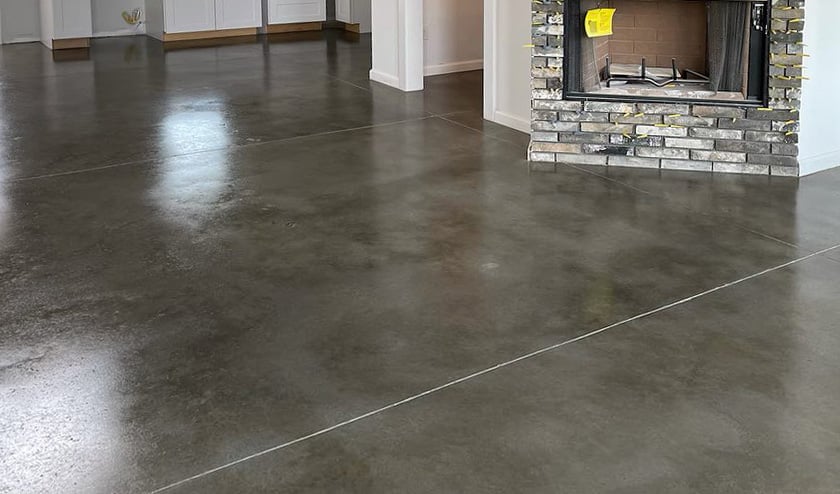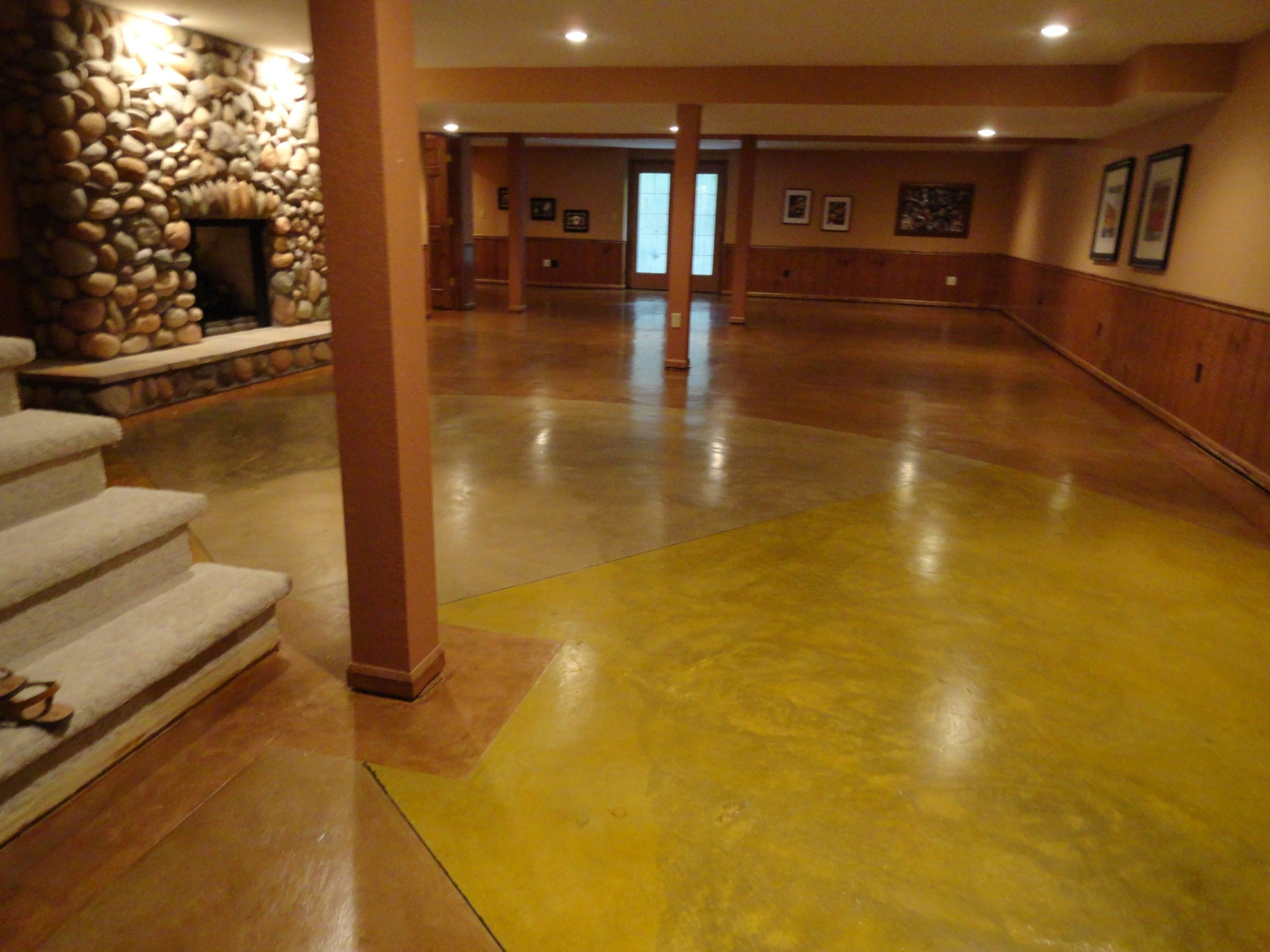Recognizing the Array of Services Offered in Flooring: Highlighting Stained Concrete Techniques
Stained concrete has actually become a compelling floor covering alternative for numerous rooms. Its convenience exists in the choice between acid and water-based discolorations, each using distinct looks. Appropriate preparation and ongoing upkeep are vital to assure its toughness and appearance. As the need for ingenious flooring remedies grows, recognizing the nuances of stained concrete methods might open up new opportunities for both property and commercial settings. What distinct benefits might this flooring option give a project?
The Essentials of Stained Concrete
Stained concrete acts as a functional flooring option that integrates longevity with aesthetic allure. This flooring method entails applying a particularly created stain to the concrete surface, which passes through and modifies the shade of the product. The procedure not just boosts the visual elements of concrete but likewise offers the benefit of protecting it from deterioration. Stained concrete can attain a large range of appearances, from natural tones to vibrant shades, making it appropriate for numerous layout themes.
Proper prep work of the concrete surface is necessary for perfect results. This might consist of cleansing, grinding, or engraving to assure the stain adheres effectively. Additionally, the application process normally entails making use of tools such as sprayers or brushes to achieve consistent insurance coverage. After staining, a sealer is commonly used to enhance sturdiness and preserve the vibrancy of the color. Eventually, discolored concrete supplies an eye-catching and durable floor covering option for property and commercial spaces alike.
Sorts of Stains: Acid vs. Water-Based

In comparison, water-based stains provide a bigger range of colors and are easier to apply. They do not react chemically with concrete yet instead supply a surface area tint - stained concrete austin. Water-based spots are reduced in volatile organic compounds (VOCs), making them extra environmentally friendly and suitable for interior projects. While they might not provide the same depth of shade as acid discolorations, their versatility and ease of use make them appealing for different applications. Inevitably, the selection relies on the project's requirements, desired appearances, and area
Strategies for Staining Concrete
The strategies for staining concrete differ substantially between acid and water-based approaches. Acid staining entails a chain reaction that produces one-of-a-kind, variegated colors, while water-based spots supply a broader palette and much easier application. Understanding these processes is important for achieving the desired visual in concrete floor covering.
Acid Staining Refine
Acid staining uses a dynamic way to boost the visual charm of concrete surfaces. This procedure includes applying a combination of water, hydrochloric acid, and pigments to the concrete, which responds chemically to produce dynamic, translucent shades. Initially, the concrete surface must be extensively cleaned up and prepped to ensure optimal adhesion. As soon as used, the acid stain permeates the concrete, developing special marbled effects as it responds with the lime in the concrete. After the preferred color develops, the surface area is reduced the effects of and washed to halt the response. A sealant is applied to protect the surface and boost toughness. Acid staining not only transforms the appearance of concrete but likewise provides a lasting remedy for decorative floor covering.
Water-Based Staining Benefits
Exactly how can water-based staining boost the aesthetic and practical qualities of concrete surface areas? Water-based discolorations use a flexible solution for improving concrete, giving dynamic shade options while ensuring ecological safety and security. Unlike acid stains, water-based options penetrate the surface, enabling even color circulation and a variety of coatings, from matte to shiny. Furthermore, they are reduced in volatile organic substances (VOCs), making them less dangerous to indoor air high quality. Their fast drying out time promotes faster job conclusion, while their resistance to fading makes sure durable beauty. Water-based spots can likewise boost the concrete's sturdiness and resistance to discolorations, making them an optimal selection for both residential and commercial applications. Eventually, they supply a sustainable, attractive service for different concrete surface areas.
Style Opportunities With Stained Concrete
Stained concrete deals a variety of style opportunities that can improve any kind of area. Techniques such as shade variant, different surface completing alternatives, and custom-made style patterns enable one-of-a-kind and individualized floor covering options. These aspects not only elevate looks however likewise contribute to the overall functionality of the concrete surface area.
Shade Variation Methods
While exploring the layout opportunities of tarnished concrete, color variation techniques play a pivotal duty in improving both aesthetic allure and capability. These methods allow for the development of distinct patterns and impacts that can transform a simple concrete surface area into a visually striking element of a space. Choices such as acid staining, which reacts chemically with the concrete, produce abundant, clear shades that resemble natural stone. Water-based discolorations offer a more comprehensive shade palette and permit even more control in design. Furthermore, layering various spots can create depth and measurement, providing a customized appearance. By integrating shade variation strategies, designers can accomplish varied styles, from rustic to contemporary, ensuring that discolored concrete fits seamlessly into any kind of design scheme.
Surface Area Finishing Options
The exploration of color variant techniques sets the phase for considering surface ending up alternatives, which significantly influence the total look and performance of tarnished concrete. Various surfaces can improve the visual appeal and longevity of the surface. Typical alternatives consist of matte, satin, and glossy coatings, each providing an unique aesthetic effect. Matte coatings offer a subtle, underrated beauty, while satin coatings strike a balance in between shine and usefulness, making them popular for property and business rooms. Shiny coatings, on the various other hand, create a high-shine appearance, improving shade vibrancy and light reflection. Furthermore, surface treatments such as polishing or sealing additionally boost longevity, making these finishing choices vital factors to consider in creating functional and visually attractive tarnished concrete floorings.
Personalized Design Patterns
Exactly how can customized design patterns boost the appeal of discolored concrete? By incorporating distinct styles, stained concrete can transform average floor covering right into a striking visual statement. Custom-made patterns, such as geometric shapes, detailed themes, or organic designs, permit personalization, making spaces feel customized and welcoming. Customers can choose from a variety of methods, consisting of saw cuts, stencils, or overlays, to accomplish desired effects. Furthermore, incorporating multiple shades with different stain techniques enhances the deepness and measurement of the patterns. These layout possibilities not only boost visual appeal but additionally boost the worth of domestic or industrial rooms. Eventually, custom layout patterns give a possibility for imagination, setting discolored concrete apart from conventional floor covering options.
Preparing Your Concrete Surface
Appropriate preparation of the concrete surface area is important for accomplishing an effective discolored coating. This procedure begins with thorough cleaning to get rid of dust, oil, and any kind of other contaminants. A stress washing machine or a flooring scrubber can efficiently get rid of these substances, making sure a tidy slate for staining. After cleaning, it is important to repair any kind of splits or blemishes in the concrete. This can be accomplished using a concrete patching compound, which ought to be permitted to heal fully before continuing.
As soon as the surface area is tidy and repaired, grinding or sanding may be needed to develop a smooth, even structure. This action enhances the concrete's ability to absorb the stain consistently. Ultimately, a concrete etcher can be put on open up the pores of the surface, permitting for much better attachment of the stain (stained concrete austin). By adhering to these prep work steps, the resulting stained concrete will show a more vibrant and enduring coating
Maintenance and Look After Stained Concrete
Maintaining stained concrete is necessary for preserving its appearance and durability after the first prep work and application of stain. Regular cleaning is essential; sweeping or vacuuming to eliminate dirt and debris protects against scrapes and continue reading this monotony. For deeper cleansing, a moderate pH-neutral cleaning agent blended with water can be utilized, complied with by complete rinsing to avoid residue buildup.
Sealing tarnished concrete is an additional vital upkeep action, as it safeguards the surface from discolorations and moisture. Relying on the sealer kind, reapplication may be necessary every one to three years. Additionally, staying clear of severe chemicals and rough devices helps preserve the stability of the stain.
For outdoor tarnished concrete, it is a good idea to clear snow or ice quickly to avoid damage from freeze-thaw cycles. Generally, regular you could try these out treatment guarantees that tarnished concrete maintains its vibrant color and structural security gradually, making it a resilient flooring choice.

Price Considerations for Stained Concrete Floor Covering
When evaluating the expense of stained concrete floor covering, potential homeowners commonly ask yourself concerning the various elements that affect pricing. Key factors to consider consist of the dimension of the location to be covered, the intricacy of the design, and the kind of stain used. Basic staining strategies tend to be a lot more affordable, while detailed patterns or multiple colors can significantly enhance costs.

Geographical area is one more element, as costs can vary widely from one area to an additional. Lastly, recurring upkeep prices need to be factored in, as sealers and protective coverings may be essential with time to maintain the aesthetic and sturdiness of the stained concrete.
Frequently Asked Concerns
Can Stained Concrete Be Applied Over Existing Flooring?
The concern of whether stained concrete can be applied over existing flooring is usually asked. Commonly, it is possible, supplied the underlying surface is clean, stable, and ideal for proper attachment of the discolored concrete.
How much time Does the Staining Process Take?
The staining procedure commonly takes a few hours to a complete day, depending on the dimension of the location and the complexity of the style. Curing may need extra time before the surface area is fully functional.
Is Stained Concrete Suitable for Outdoor Use?
Stained concrete is indeed appropriate for outdoor usage, as it endures various weather problems. Its resilience and visual appeal make it a popular option for patio areas, pathways, and driveways, enhancing both functionality and aesthetic rate of interest.
Can I Adjustment the Shade of Stained Concrete Later On?
The ability to change the shade of tarnished concrete later on depends upon different variables, consisting of the original stain type and surface area preparation. Consulting a specialist click now can supply support on potential choices and results for color modification.
Are There Eco-Friendly Options for Stained Concrete?
The inquiry concerning environment-friendly alternatives for stained concrete exposes a growing rate of interest in sustainable structure techniques. Lots of companies currently offer low-VOC stains and eco-friendly sealers, making sure visual appeal while minimizing environmental effect.